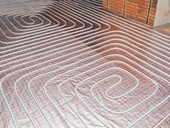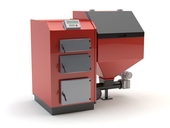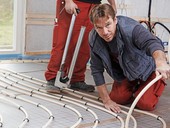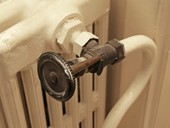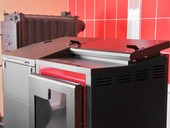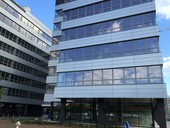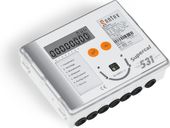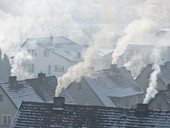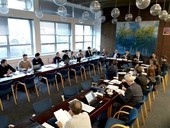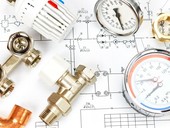Floor heating supplies heat in heated rooms by transferring from the floor. A large part of the heating system is installed in the floor. For a number of benefits, underfloor heating is being built in living rooms, family and apartment buildings, utility rooms, shops, industry, etc., and more often than ever before. It is also common today to combine several different types of heating, with the floor forming the base. In the event that the floor heating is designed with a hot water form, its function of distributing heat to the rooms can be turned to remove heat from the rooms and then serve for cooling.
Archiv článků od 29.10.2018 do 29.5.2019
The paper deals with the emission of noise from chimneys and air-conditioning exhausts in the free space. Chimneys in general are vertical flue ducts designed to remove flue gases from combustion devices. The paper does not only address these cases, but extends to the termination of vertical piping systems into the atmosphere in general, addressing also the case of the discharge of degraded air into the outdoor environment through a pipeline of a certain dimension.
The knowledge of internal heat gains from people performing certain activities is important for energy simulation calculations. The most commonly used data are present in Czech standard for heat load calculation, based on the values specified in ASHRAE. The standard greatly simplifies heat production from children. A calculation based on the heat balance presents a production of sensible and latent heat from people, depending on age, physical proportions, type of activity and thermal conditions in space. The results are compared with the data presented in the literature including the ratio between convection and radiation heat flow. The main goal of the analysis is to determine the heat flow from the children as an input for energy simulation calculations of school buildings.
In the case of building management, innovation is mainly used to improve the quality of the indoor environment and the comfort of people in the bulding. The role of the energy management of buildings is getting to a whole new position, where each measure is considered not only by looking at money and financial savings, but also by performance and above all health of people.
Paper deals with the definition of energy flexible building, its impact on the stability of the grid with the planned increasing share of energy from renewable sources and the possibility of using the heat storage capacity of building structures. Paper further analyzes the selected methodology for evaluation of the energy flexibible building and gives an example of thermally activated building structures.
The paper deals with the analysis of thermal losses of pipe distributions in the small solar system model created in the TRNSYS energy simulation tool. Attention is paid to the impact of heat loss through pipelines on the overall energy balance. Several variants of pipe lengths for one type of system have been selected. The results presented in the articles illustrate the influence of different pipe lengths on heat losses and the consequent impact on the energy balance of the monitored system.
The author draws attention to the need to pay special attention to the measurement of heat conveyed by liquids other than water. The properties of mixtures of water and different substances have different thermodynamic properties than water and if the heat meter cannot be set for other measurement conditions, the measurement error may reach up to 100% in extreme. The properties of liquids in relation to the construction of heat meters are discussed. In conclusion, the author adds recommendations, the observance of which would help to ensure measurement accuracy.
The article describes the current approach of the Czech legislation to waste incineration in households, describes the origin and principle of the method for detecting incineration or co-incineration of waste. At the end of the article, what is the subsequent procedure for demonstrating waste incineration and what sanctions are threatened by the owner of the incinerator.
Virtual models of spaces, devices, humans, and their interconnectedness with mathematical descriptions of the interactions between them allow for shorter time in finding the optimal variation. Many processes are neither realistically traceable at the micro level, and can be derived only on the basis of the consistency of simulations and real measurements at the macro level. The TZB area offers a wide range of computer simulations, as lectures at the conference.
In July 2018, a two-year monitoring of the FENIX Group a.s. in Jeseník. During this time, different battery operating modes were applied to test their capabilities to ensure the power operation of the object. This article describes the entire period in terms of energy flows in the building. The key parameters are energy consumption, supply to the grid, self-sufficiency of the building from the photovoltaic source and its local use. A number of articles have been written about the building, detailing the building and energy aspects [1, 2]. Therefore, the description of the energy economy in the building will be given only to the extent necessary for a general view of the building's energy.
The "size" of the control system has a significant impact on how individual actors in the supply chain - investor, designer, salesman and implementation technician or programmer - are approaching it. But how do you determine the size - and how do you define it at all? In terms of measurement and regulation, we can highlight two main factors: range and complexity.
As a condition for the data from the heat meter to be within the permissible tolerance field, it is correct to determine the operating conditions of the gauge and to adapt the gauge selection. Not only at the stage of designing and installing the meter, but throughout its operation. One of the critical parameters is the minimum temperature difference and the minimum flow, which changes very often after insulation of the buildings, after the modernization of the heating systems of individual apartments. In terms of accuracy, there is no difference between bills for billing purposes and gauges used to use their data to optimize the operation of heating or cooling systems.
The methodology for determining energy-neutral or energy-zero houses is different at national levels. The interest in the realization of such houses is not only influenced by the methodology but also by the market conditions in the area of moving surplus energy production from one object to another. This is an economically disadvantageous purchase price when delivering to the network. If the existing conditions in the Czech Republic are not changed, the implementation of energy-zero houses for investors will not be interesting and the potential for reduction of CO2 production will not be utilized.
The methodology for determining energy-neutral or energy-zero houses is different at national levels. The interest in the realization of such houses is not only influenced by the methodology but also by the market conditions in the area of moving surplus energy production from one object to another. This is an economically disadvantageous purchase price when delivering to the network. If the existing conditions in the Czech Republic are not changed, the implementation of energy-zero houses for investors will not be interesting and the potential for reduction of CO2 production will not be utilized.
The article compares the behavior of two-pipe heating system with counter-flow and with concurrent-flow and single-pipe heating system with bypass of radiators. It focuses on changing different parameters such as return water temperature, radiator output or temperature in the heated space when closing the control valves for radiators.
zpět na aktuální články
